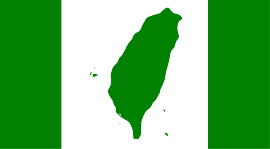Republic of China on Taiwan
Republic of China on Taiwan is a political term as well as discourse regarding the present status of the Republic of China. It is proposed by former president of the Republic of China Lee Teng-hui, the first Taiwanese President. During his presidential tenure in 1995, Lee visited his alma mater Cornell University and mentioned this term for the first time when delivering an Olin Lecture.[1][2][3][4]
The term is one of the several terms regarding the Republic of China, and is not exactly about Taiwan independence. The term was later included in the Four-Stage Theory of the Republic of China as the third stage from 1988 to 2000 by President Lee's successor Chen Shui-bian.)[5][6][7]
Background
Before Lee Teng-hui coined the term, the officials of the Republic of China had always used the state's official name "Republic of China". Therefore the term was regarded as a breakthrough.[8][9]
In regards to the origin of the term, Lee Teng-hui explained in 2005 during a lecture in Lee Teng-Hui Institute that, following the World War II, Chiang Kai-shek's forces temporarily occupied the island of Taiwan under the direction of Supreme Commander for the Allied Powers Douglas MacArthur, and because both the Treaty of San Francisco and the Treaty of Taipei concluded afterwards did not explicitly specify to whom Japan renounced the sovereignty of Taiwan for, the legal status of Taiwan has become undetermined, and therefore he coined the term "Republic of China on Taiwan".[10][11]
Position of the People's Republic of China (PRC)
The government of the People's Republic of China claimed: “The reunification of China must be achieved. We never allow the seceding of Taiwan from China through 'Two Chinas', 'One China, One Taiwan', or any other means.”[12]
See also
- Four-Stage Theory of the Republic of China
- Taiwan after World War II
- Legal status of Taiwan
- Politics of the Republic of China
- Elections in the Republic of China
- President of the Republic of China
- Four Noes and One Without
- Taiwanization
References
- ↑ 總統李登輝訪美國康乃爾大學,臺灣民主受推崇, Government Information Office (Chinese)
- ↑ 民國84年李登輝總統於康乃爾大學歐林講座發表演講, National Central Library (Chinese)
- ↑ Text of Lee's Cornell address, TAIWAN INFO, Ministry of Foreign Affairs, 1995-6-16
- ↑ 國家定位 李前總統︰ROC在台灣, TVBS, 2003/12/21
- ↑ Mainland Policy and Work - August 2, 2005, Mainland Affairs Council, 2005
- ↑ Chen says name variance is simply an expedient, Taipei Times, 2005/8/3
- ↑ Chen urges unity to deal with China, Taipei Times, 2005/8/3
- ↑ Text of Lee's Cornell address, TAIWAN INFO, Ministry of Foreign Affairs, 1995-6-16
- ↑ 國家定位 李前總統︰ROC在台灣, TVBS, 2003/12/21
- ↑ 陳永昌 (July 4, 2005). "李登輝:台灣要獨立 應與美國談法定地位". Central News Agency (in Chinese). Taipei. Retrieved June 13, 2016.
- ↑ 李欣芳 (July 5, 2005). "李登輝:台灣要獨立 應跟美談法定地位". Liberty Times (in Chinese). Taipei. Retrieved July 11, 2016.
- ↑ "中国政府坚决反对"两个中国"、"一中一台"等分裂主张". Xinhuanet (in Chinese). Archived from the original on June 20, 2003. Retrieved February 13, 2015.
